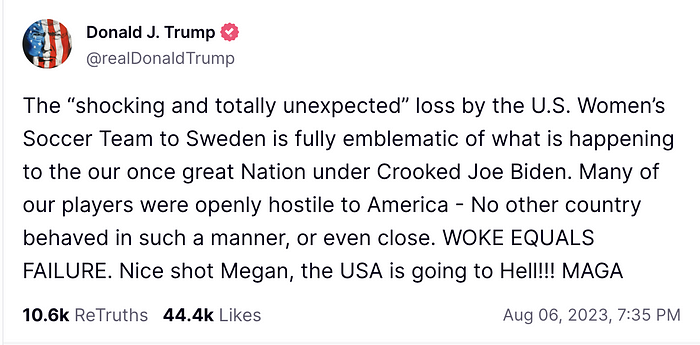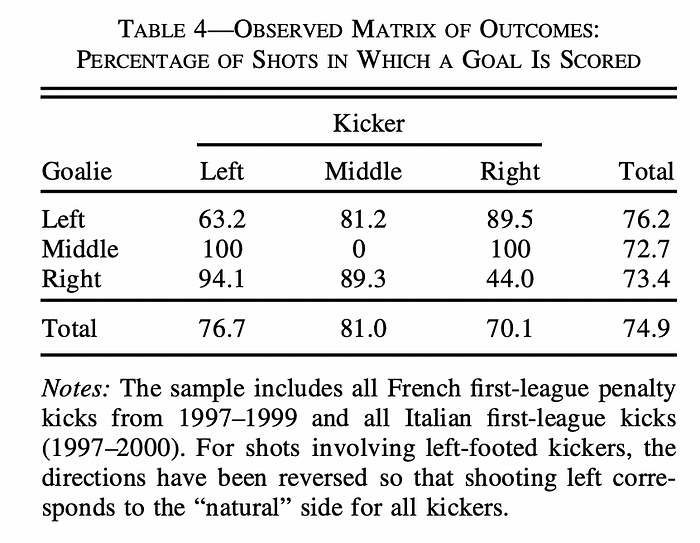The Economics of the US Women’s Soccer Loss
The US Women’s soccer team was eliminated from the World Cup over the weekend in an overtime penalty kick shootout against Sweden. The outspoken Megan Rapinoe was one of the American players who missed in the 5–4 loss, sending her shot sailing over the right side of the crossbar.
The right wing punditry zoomed into action, for example with Donald Trump posting on Truth Social:

Over on Twitter, Matt Walsh posted a video clip of Rapinoe’s miss and claimed:
Walsh’s analysis was particularly ironic, since he is the creator of the hit documentary “What Is a Woman?” The entire thrust of this tongue-in-cheek production is to mock Walsh’s left-wing opponents who — when it comes to transgender issues — are so consumed by ideology that they can’t acknowledge basic facts about biology.
Yet in the current case, Walsh and his allies were so consumed with contempt for Rapinoe’s politics — she has been an ardent champion of equal pay for the Women’s soccer club — that they engaged in the above hyperbole with a straight face.
The “Game Theory” of Penalty Kicks in Soccer
Needless to say, if Walsh has zero soccer experience, then in no meaningful sense could he have “done better” than Rapinoe’s missed attempt. Even supposing he managed to keep his shot “on net” with thousands of people watching him, without prior experience Walsh would probably telegraph where his shot was going, and kick it so tepidly, that a professional goalie would easily stop it.
Still, why would someone at the caliber of the World Cup sail the ball over the crossbar like Rapinoe did? Well, before we judge her too harshly, we should point out that two other women missed the goal in the very same shootout — one lady from Sweden and another from the US. So notwithstanding the commentary from the conservatives, it’s not “shocking” that a pro would do this. For example, Italy’s Roberto Baggio missed a clutch penalty shot by sailing it over the crossbar in a 1994 World Cup loss to Brazil, even though the year earlier Baggio had won the FIFA title of World Player of the Year.
Using standard tools of economics, we can analyze why soccer pros sometimes miss like this, even though to outsiders (like Matt Walsh) sailing a penalty kick over the crossbar exhibits apparently awful skills.
What’s happening is not merely an athletic clash of skills, but a strategic battle of the mind. Specifically, the shooter in a penalty kick has to decide where to aim the ball. The goalkeeper is doing the same thing.
Obviously if there were no goalie involved, Rapinoe would have kicked the ball directly into the middle of the net. But since the goalie is there, things are much more difficult. Ironically, kicking the ball directly at the middle sometimes does work — look at the 11th shot of the shootout, when the US goalkeeper Alyssa Naeher drills it straight at where the Swedish goalie was originally standing, but who miscalculated and jumped out of the way (anticipating the shot would go to her right).
As in many things in economics, here too with penalty kicks there are tradeoffs involved. The “safer” the kick — meaning the more certain the kicker is that it will be “on net” — then the easier it is for the goalie to stop it, if the goalie correctly guesses where the shot will be aimed.
So in terms of economic game theory, it isn’t a Nash equilibrium — meaning an outcome where both players are happy with their chosen strategies — for the kicker to always take very safe shots centered on the net, because then the goalie would always stand still. This is why players — such as Rapinoe — aim for top corners, because if their aim is accurate, such a shot is virtually impossible to stop.
An Empirical Test
Believe it or not, economists have done formal analyses of penalty kicks in soccer. For example, the Freakonomics author Steven Levitt and two colleagues published a journal article in the top-ranked American Economic Review entitled, “Testing Mixed-Strategy Equilibria When Players Are Heterogeneous: The Case of Penalty Kicks in Soccer.” The economists created a simple model where kickers and goalies could choose either Left, Right, or Middle, and used data from French and Italian elite clubs over a 3-year period (covering 459 penalty kicks) to test their model’s predictions.
It is difficult to give a concise yet accurate summary of the paper’s results. For our purposes in this article, I’ll relay three of the main findings:
First, the kickers exhibited a “mixed strategy,” meaning that no individual kicker always (say) aimed Left. Presumably if a kicker did adopt such a strategy, rival coaches would catch on to the pattern by studying previous games and would inform their own goalie accordingly.
Second, each kicker seems to have a “natural” advantage in a particular side, based on which foot he uses. Specifically, right-footed players are more likely to score (other things equal) when aiming Left.
Third, in practice the goalie has an equal likelihood of success regardless of which strategy he chooses for a particular shot. The following table illustrates these findings:

To understand the table, consider the top left value. This is showing that when the kicker aims Left, and the goalie goes to the same side (which would be the goalie’s right of course), then there is still a 63.2% chance that the kicker scores. In contrast, if the kicker aims to the Right and the goalie correctly anticipates, then the success rate drops to 44.0%. This is consistent with the idea that a right-footed kicker is better able to zoom the ball in when aiming left, even if the goalie guesses correctly. (As the text under the table explains, for left-footed kickers the authors reversed the classification to make it consistent.)
Another interesting observation is the middle cell: If the kicker aims for the Middle, and the goalie stays still, then there is a 0% chance of scoring. This all makes perfect sense.
The final observation to make regarding the table is that from the goalie’s perspective, there is little difference among the various strategies. Specifically, across all the times the goalie chose Left, 76.2% of the shots scored, while choosing Middle yielded 72.7% scores, and choosing Right meant 73.4%. (The goalie obviously wants to minimize the percentage of successful shots.) Given the vagaries in the data, the authors concluded that this outcome was consistent with the hypothesis that the goalies achieved the same payoff from any particular strategy, given the behavior of the kickers.
In contrast, from the kicker’s point of view, this data set revealed that shooting dead center had the highest success rate (81.0%), much higher than shooting to their weak side (70.1%).
The authors explain these results by arguing that for all intents, we can model goalies in professional soccer as interchangeable, whereas kickers are unique and they cannot be aggregated into a simple model.
Conclusion
Notwithstanding the chortling of conservative pundits, Megan Rapinoe’s missed penalty kick was not proof of her incompetence. Much like the faceoff between a pitcher and batter in baseball, the interplay of goalie and kicker in soccer penalty shootouts involves not just physical prowess but also mental cunning.
NOTE: This article was released 24 hours earlier on the IBC Infinite Banking Users Group on Facebook.
Dr. Robert P. Murphy is the Chief Economist at infineo, bridging together Whole Life insurance policies and digital blockchain-based issuance.




Comments